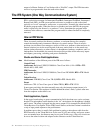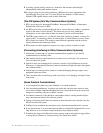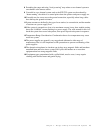
38 Handbook of Intercom Systems Engineering
Headphone Impedances
Low impedance headphones are louder, causing the user station to draw more current from
its power source. High impedance headphones are not as loud, drawing less current. Many
user stations have a headphone impedance range from 25 - 600 ohms.
Headphones up to 2,000 ohms will function but greatly reduced levels. In a double muff
headset such as a Beyer DT-109, there are two 50 ohm headphones connected in parallel
resulting in an impedance of 25 ohms.
Wiring Practices/Workmanship Standards
The two most significant wiring practice/workmanship problems are as follows:
1 Unintentional grounding, phase reversals (channel reversing) and power reversal. Cable
shields must not touch connector shells or be tied to the connector shell lug. Cables
(especially the vinyl insulated type) must not be pulled tight around sharp edges.
2 Line noise due to an intermittent connection:
Poor solder joint.
Corroded connector.
Loose screw terminal.
An non-insulated cable shield touching the metal shell of the connector.
Portable user stations should not arbitrarily be taped or fastened to metal structures.
Grounding the case of the user station to an arbitrary structure may introduce large noise
voltages due to local ground currents or due to the completion of a “ground loop antenna”.
Phase reversals are most common with portable microphone cable that has not been
checked with a standard cable tester after fabrication or repair.
DC power reversals are usually not harmful to user stations since there is normally a
protective diode in the circuit. The station simply doesn’t work. Remember: negative is
ground in this system.
Always clear all earth grounds from the RTS™ TW System circuit return ground.
The only ground should be the 22,000 ohm resistor in the power supply.
Unbalanced vs. Balanced
Intercom systems such as the TW System, in the standard, unbalanced configuration have
been operated at distances of up to two miles with acceptable system noise levels. Routing
the intercom cables along the same ductways and pathways as the main power cabling can
increase the noise and hum levels in the system.
If intercom cables have to be routed in this manner at distances over 300 meters (1,000 ft.),
a balanced conversion should be made.
Alternatively, the entire system can be operated in an optional balanced mode and be
powered at each station with the “local power” option. This is sometimes called “dry line,
balanced” operation.
Extended Range On Part Or All Of The System
If a station is locally powered, operational range can be extended up to five miles, using
two transformers to step up the line impedance to 800 ohms (for lower losses). When the
users station has the four wire / 800 ohm option installed, operation is possible up to 20
miles along Telco dry pairs. Operation over longer distances (3000 miles) is possible using
dial up or minimum loss dry lines and the TW series of interfaces.


















